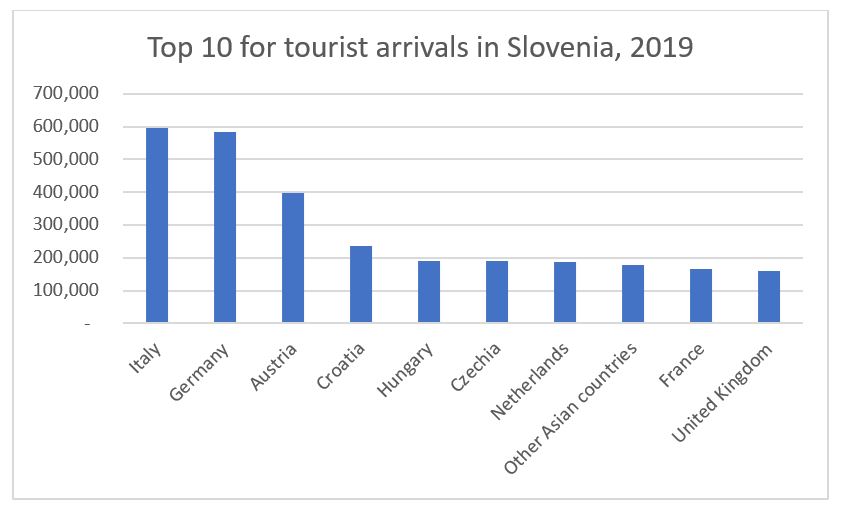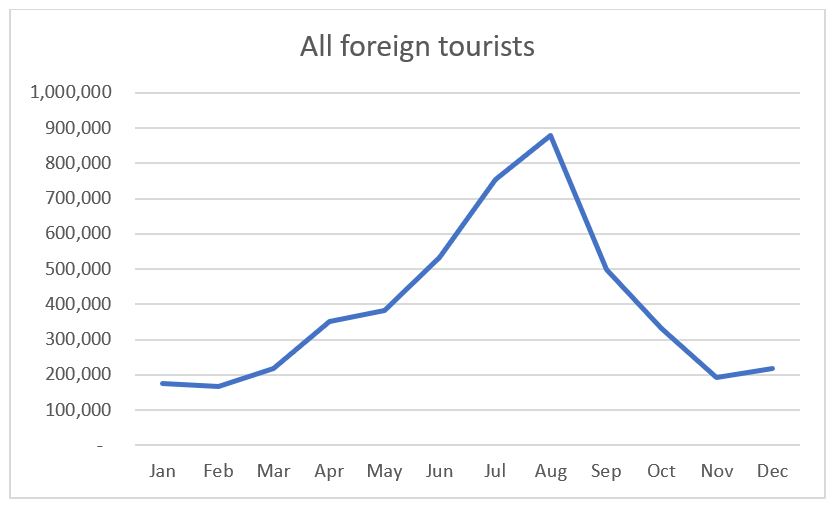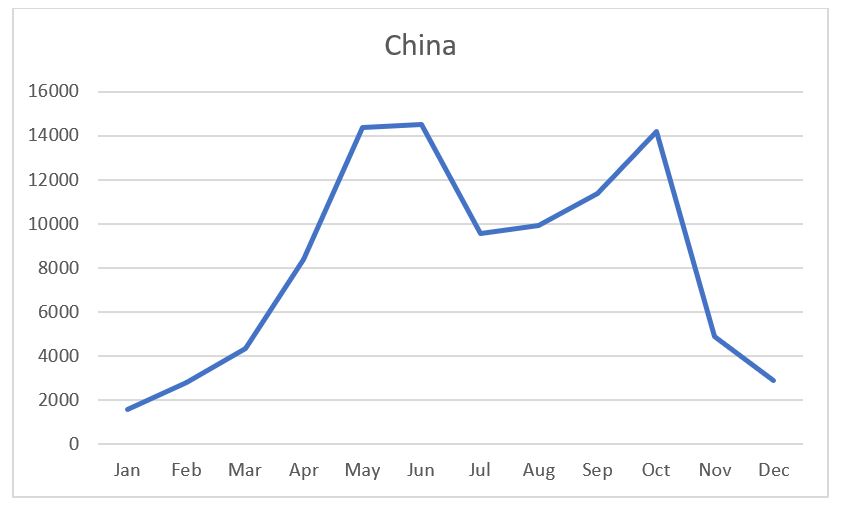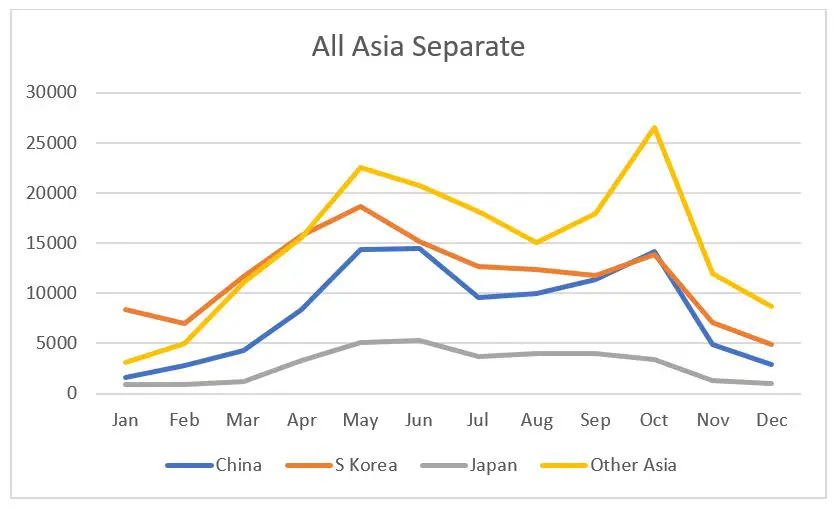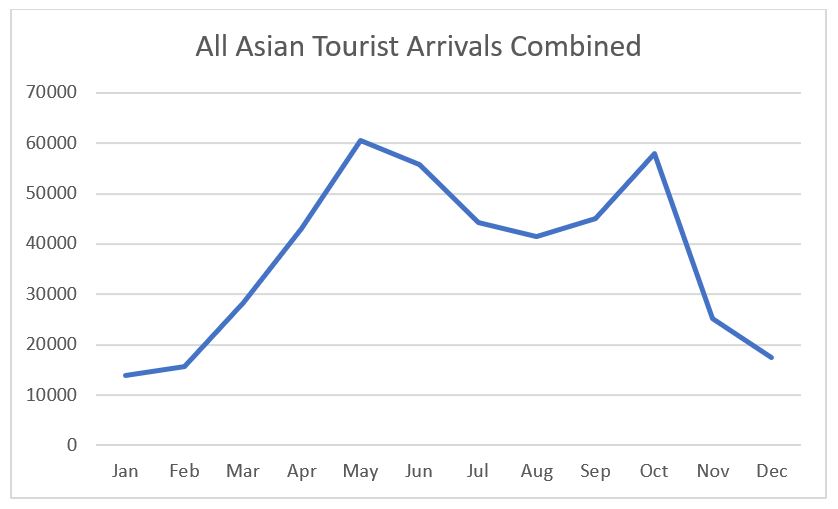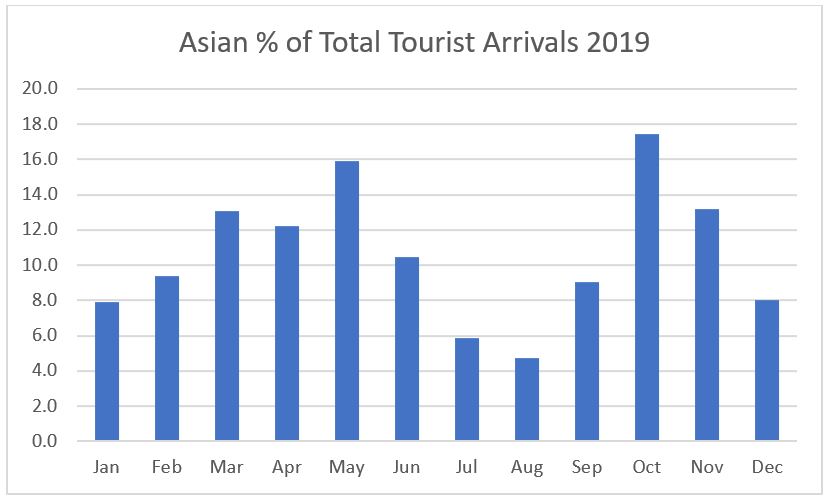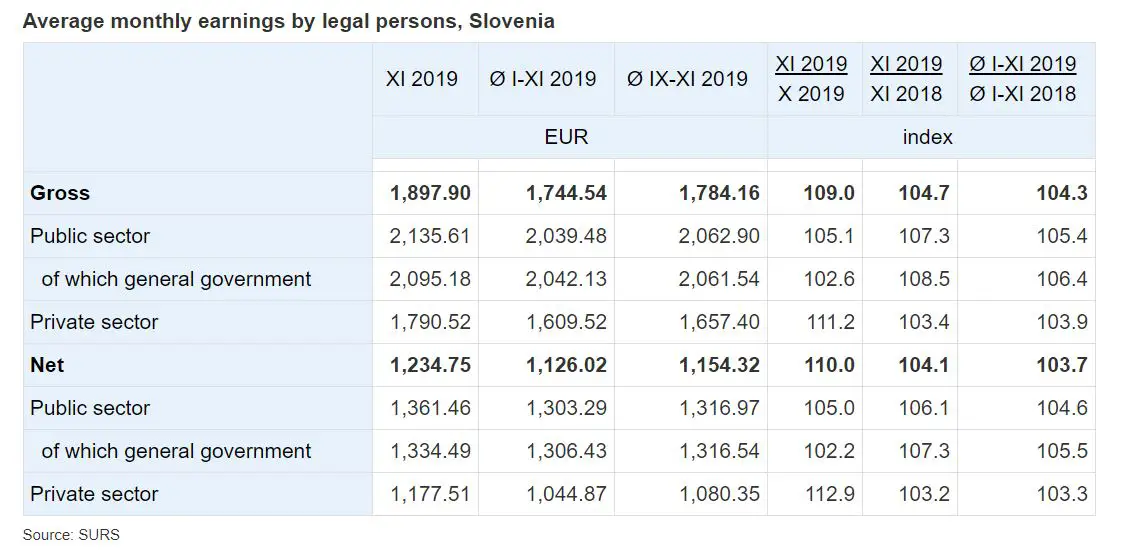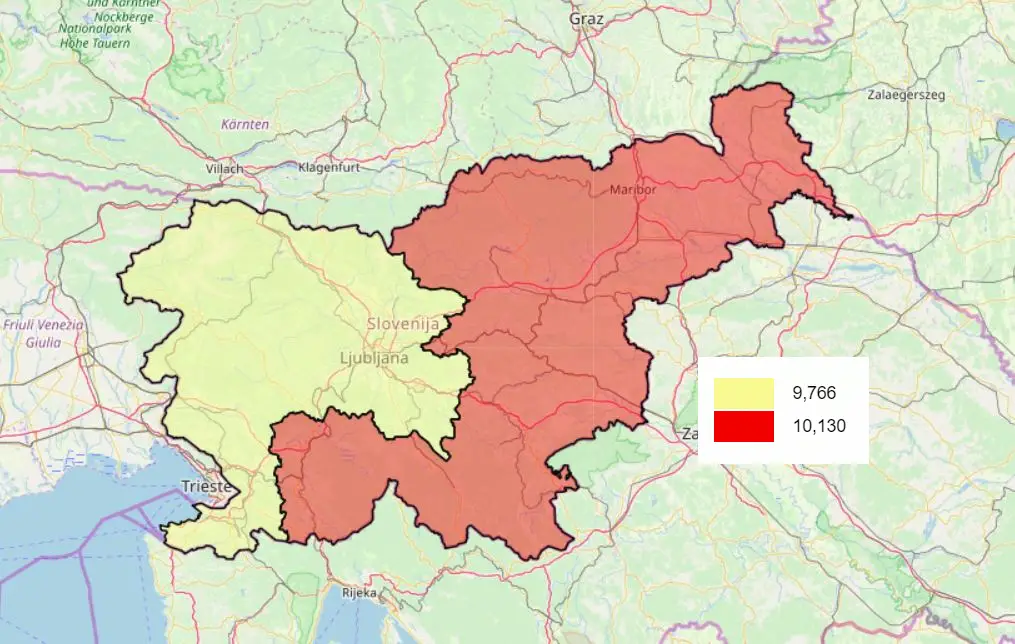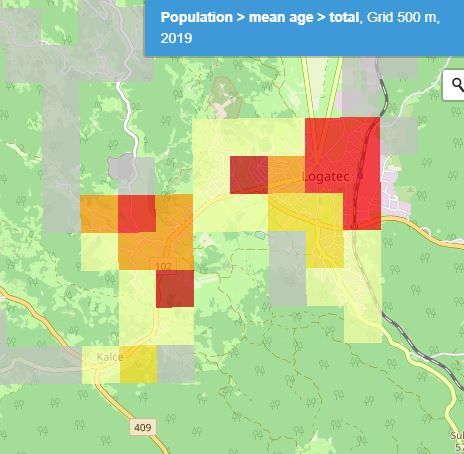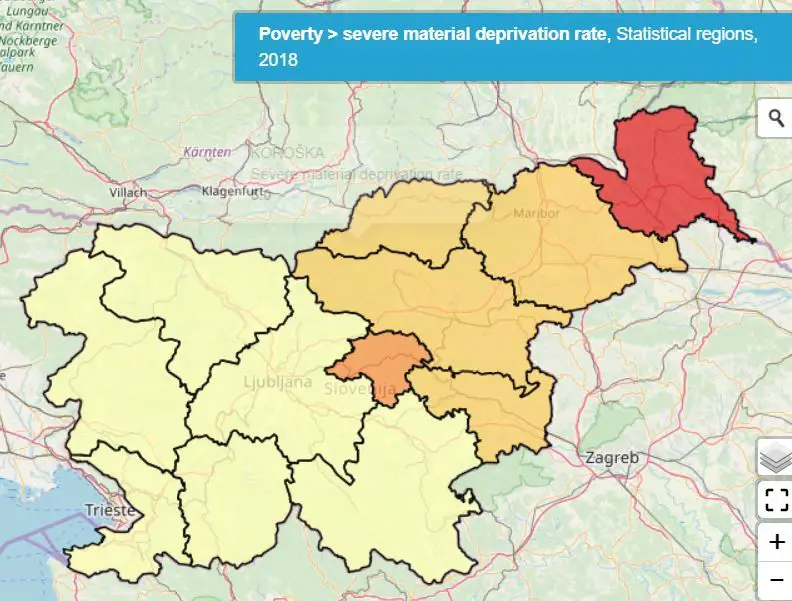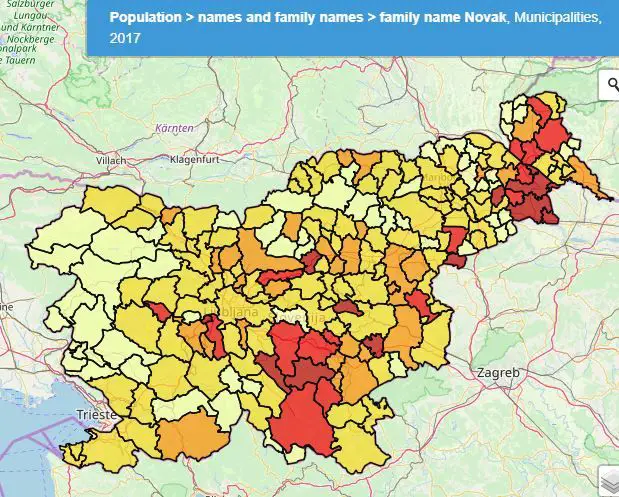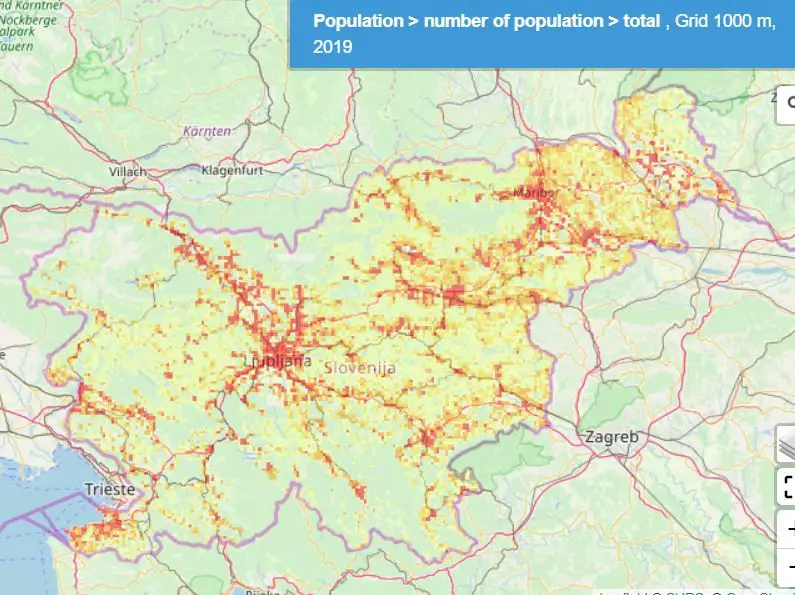Ljubljana related
SURS just released the full tourist figures for 2019, and although we already published a summary we thought we’d dig a little deeper into the data, to find some other trends and points of interest, with the top 10 nations for the year shown below (and the full list at the end of the story).
*Other Asian countries includes all Asian nations other than China, Japan and South Korea
When looking at the monthly data for all foreign tourists, the first thing to note is the extreme seasonality of such visits. The lowest figure, 167,689, was for February, while the highest, 879,291, was in August, with June to September all months with more than a half a million arrivals.
Of course, given the habit of summer vacations, and the fact that most visitors are from Europe, this isn’t surprising. But what about places with other traditions? The data for North East Asia – China, S Korea and Japan – shows a different picture, as does that for Other Asian countries (such as India, which isn’t yet pulled out of the data on its own) .
Related: Chinese Tourism Booming in Slovenia, Ex-Yugo Nations
Looking at China alone and there are two peaks, either side of the August one for tourism in general, with a very off-trend spike in October. It’s much the same story elsewhere in Asia, as seen below in a chart for China, South Korea, Japan and “Other Asia”. All have peaks outside the high summer, in late spring and – with the exception of Japan – in autumn, too.
Combining all the numbers in the chart above gives the following for the whole of Asia.
This line can then be overlaid on the one for the whole world, producing the following image.
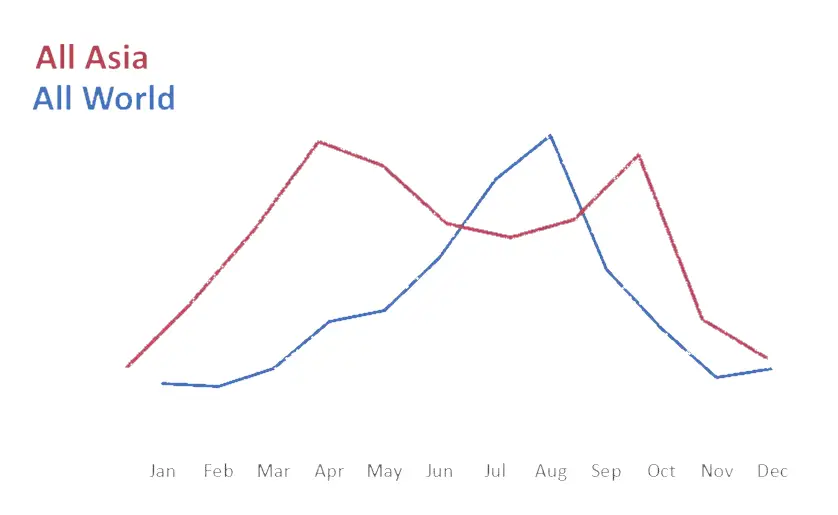
Finally, I took a look at the percentage of tourist arrivals from all of Asia by month, with it being 9.5% for the whole. There are two months where such tourists account for more than 15% of the total, in May (15.9%) and October (17.4%).
The data thus suggest that one way to reduce the seasonal nature of tourism in Slovenia, and the trade in related goods and services, would be to continue and extend efforts promote the country as a destination in Asia, as tourists from this region tend to avoid the peak summer months and arrive out of season. You can learn more and play around with the SURS data here.
The full list of nations and regions for which data on tourist arrivals in 2019 is available is shown below.
| Italy | 597,553 |
| Germany | 584,837 |
| Austria | 396,527 |
| Croatia | 235,020 |
| Hungary | 190,980 |
| Czechia | 189,829 |
| Netherlands | 186,721 |
| Other Asian countries | 176,454 |
| France | 166,870 |
| United Kingdom | 159,720 |
| United States | 148,751 |
| Serbia | 144,850 |
| Korea (Republic of) | 139,451 |
| Poland | 132,601 |
| Belgium | 113,871 |
| China | 98,975 |
| Spain | 88,138 |
| Switzerland | 78,696 |
| Bosnia and Herzegovina | 72,112 |
| Russian Federation | 69,868 |
| Slovakia | 64,758 |
| Israel | 59,615 |
| Romania | 57,095 |
| Australia | 53,732 |
| Ukraine | 44,114 |
| Bulgaria | 38,015 |
| Sweden | 36,864 |
| Canada | 35,069 |
| Japan | 33,918 |
| Turkey | 28,048 |
| Other countries of South and Middle America | 26,248 |
| Denmark | 25,881 |
| Other European countries | 25,732 |
| Finland | 25,538 |
| North Macedonia | 22,543 |
| Ireland | 21,358 |
| Brazil | 16,755 |
| Portugal | 16,283 |
| Norway | 14,438 |
| Montenegro | 13,307 |
| Greece | 12,374 |
| New Zealand | 10,009 |
| Other African countries | 8,927 |
| Lithuania | 8,178 |
| Malta | 6,899 |
| Latvia | 6,890 |
| Estonia | 5,406 |
| South Africa | 4,490 |
| Luxembourg | 3,941 |
| Iceland | 2,953 |
| Cyprus | 1,227 |
| Other countries of Oceania | 396 |
STA, 15 January 2020 - Slovenia's road safety statistics for 2019 shows a 12% increase in the number of road traffic deaths - more than 100 persons lost their lives in road accidents last year, mostly due to drink driving, speeding and reckless driving. The Traffic Agency has highlighted the importance of raising awareness about responsible driving.
Almost 50 persons died as a result of speeding, followed by some 20 dying because of wrong-way driving, and twelve due to drivers forcing the right of way.
Drivers under influence caused more than 1,520 accidents, killing some 30 persons involved in them, a slight increase compared to the year before. Drink drivers were thus responsible for one out of three road fatalities in 2019.
Related: Interior Minister, Hospitality Industry Oppose Stricter DUI Rules
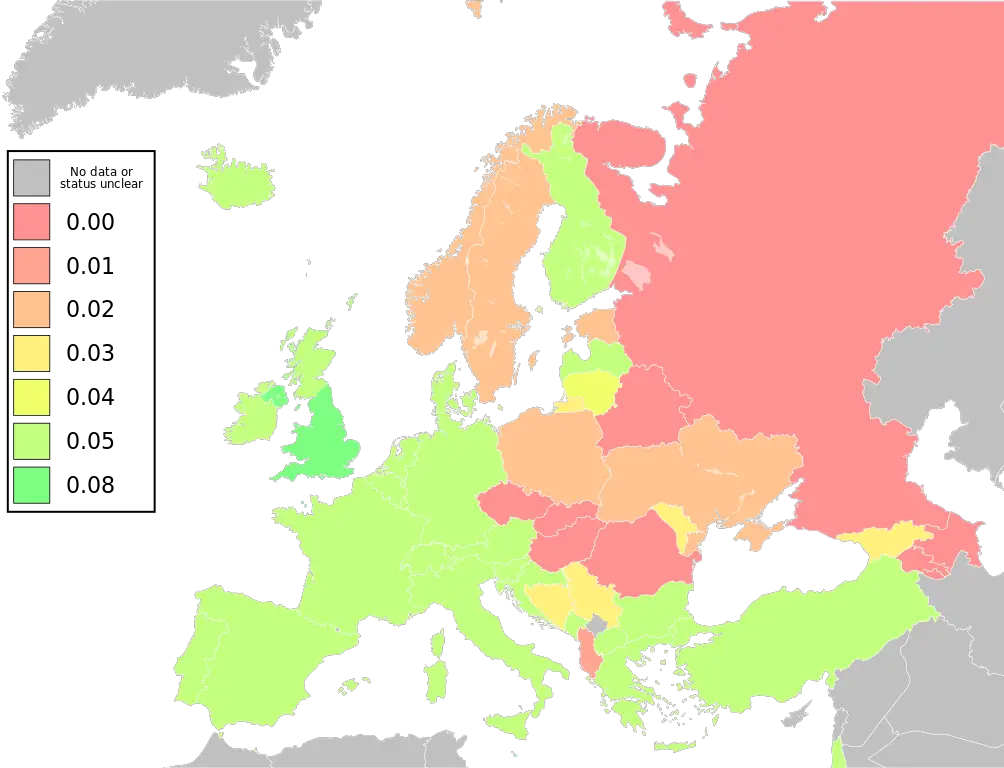
Source: Wikipedia
Almost half of total road accident victims were traffic participants from vulnerable groups - motor riders, pedestrians and cyclists.
Despite the larger number of road accidents, there were fewer seriously injured people though.
The agency's head Vesna Marinko said at today's press conference that last year's figures were not promising, but the situation was improving taking into account a longer timeline.
Related: Coffee, Cigarettes & Alcohol – Slovenia’s Place in the World
She warned about the dangers of drink driving and urged drivers to exercise caution and responsible driving.
Ivan Kapun, the head of the General Police Department's Traffic Police, said that alcohol abuse was ingrained in society, but the police had noted that most young drivers in cities found it unacceptable to be drunk behind the wheel.
Apart from driving under the influence, mobile phone use is another issue posing danger to road safety. The agency has thus launched a prevention campaign in cooperation with the police raising awareness about the dangers of using a phone while driving.
Related: Youth Say No to Cigarettes & Alcohol, Yes to Marijuana & Social Media
STA, 15 January 2020 - Slovenia's average net pay for November was EUR 1,235, up by 10% in nominal terms and 9.9% in real terms compared to October and by 4.1% nominally year-on-year. The surge was due to extra payments at the end of year, such as Christmas and performance bonuses, shows the Statistics Office data released on Wednesday.
Meanwhile, the average gross pay rose by 9% nominally to EUR 1,898, up 8.9% in real terms compared to October.
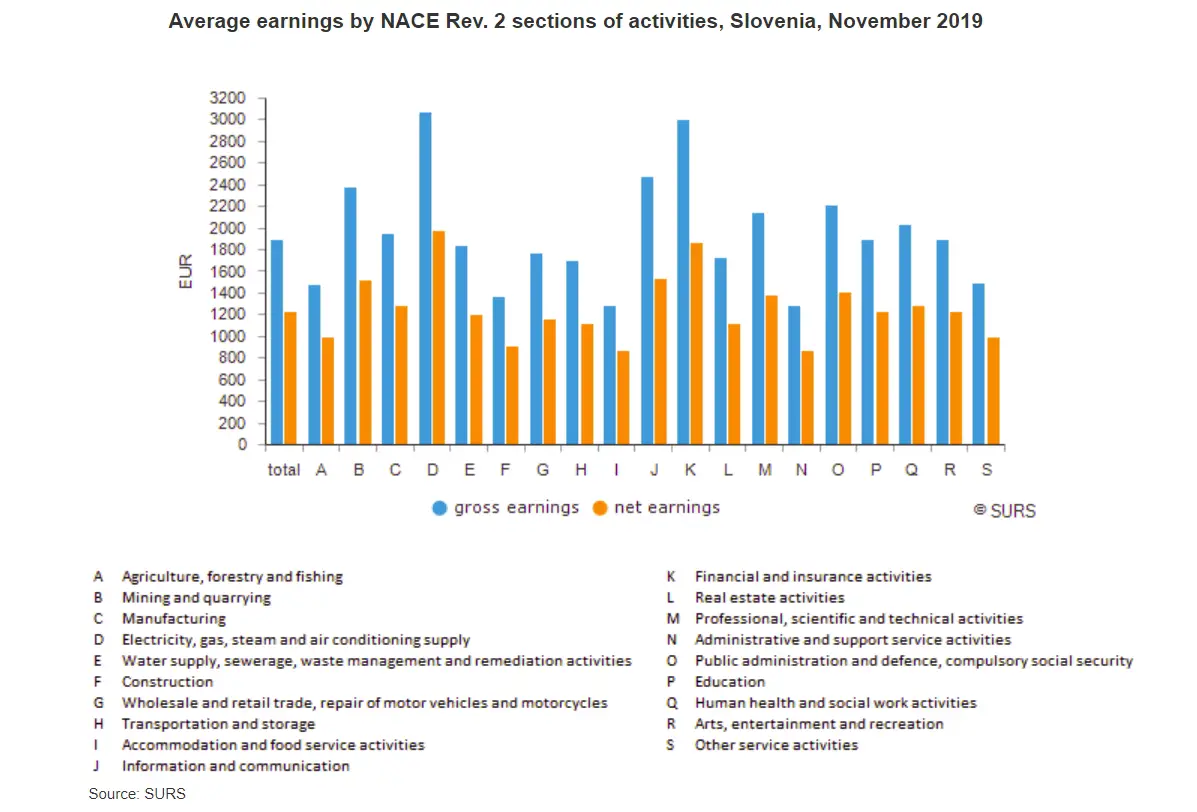
The average gross extra payment in November amounted to EUR 724, with around 23% of employees receiving the sum, mostly level with 2018.
The November average net salary increased by 2.7% in real terms year-on-year. At a monthly level, the figure grew both in the private sector (+13%) and public sector (+5%), increasing the most in financial and insurance business (+24%).
Moreover, the average net pay for November grew in the electricity, gas and steam sector (+24%), where it was the highest (EUR 1,975), and in manufacturing (+17%).
You can learn more about the images on Slovenia’s euro coins here: Slovenia in your pocket – coins that celebrate the culture
Ever wondered where all the second homes are in Slovenia, the vikendi and those defined by the Statistical Office of the Republic of Slovenia (Statistični urad Republike Slovenije – SURS) as “dwellings reserved for seasonal and secondary use”? If so, wonder no more as we zoom in the data for 2018, the most recent year for which it’s available.
According to SURS, in 2018 there were a total of 19,896 such dwellings in Slovenia. Of these, 9,766 (49%) were in the west, and 10,130 (51%) in the east.
But that scale, the two “cohesion regions”, hides a lot of detail, and if we look at the 12 statistical regions then something become clear: that Gorenjska (AKA Upper Carniola) seems to be the most desired location, with 3,376 holiday homes, or just under 17% of the total, as seen in the following map and table.
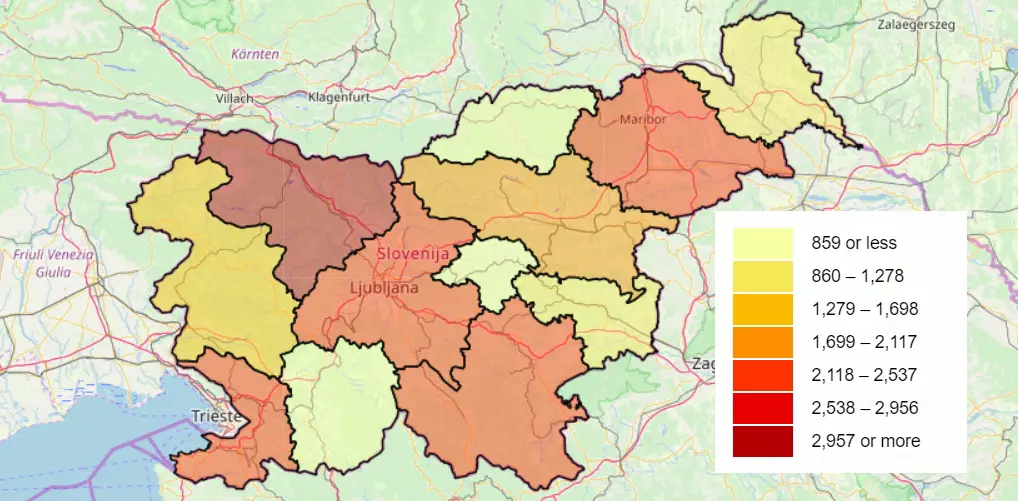
| Slovene | English | # | % |
| Gorenjska | Upper Carniola | 3,376 | 5.22 |
| Osrednjeslovenska | Central Slovenia | 2,489 | 12.51 |
| Obalno-Kraška | Coastal–Karst | 2,333 | 11.73 |
| Jugovzhodna Slovenija | Southeast Slovenia | 2,324 | 11.68 |
| Podravska | Drava | 2,168 | 10.90 |
| Savinjska | Savinja | 2,078 | 10.44 |
| Goriška | Gorizia | 1,568 | 7.88 |
| Posavska | Lower Sava | 1,037 | 5.21 |
| Pomurksa | Mura | 988 | 4.97 |
| Koroška | Carinthia | 650 | 3.27 |
| Zasavska | Central Sava | 446 | 2.24 |
| Primorsko-Notranjska | Littoral–Inner Carniola | 439 | 2.21 |
And the most popular place to buy a holiday home in Slovenia is...
Now zooming in to the highest level of detail that SURS offers – the 212 municipalities – we can see that there are seven areas where there are more than 500 holiday homes: Piran (1,038), Kranjska gora (961), Bohinj (843), Bovec (608), Brežice (526), Ljubljana (523), and Izola (512). You can visit an internactive version of the map below here and learn more, if wanted, while if you’re interested in more statistics about Slovenia then all our related stories are here.
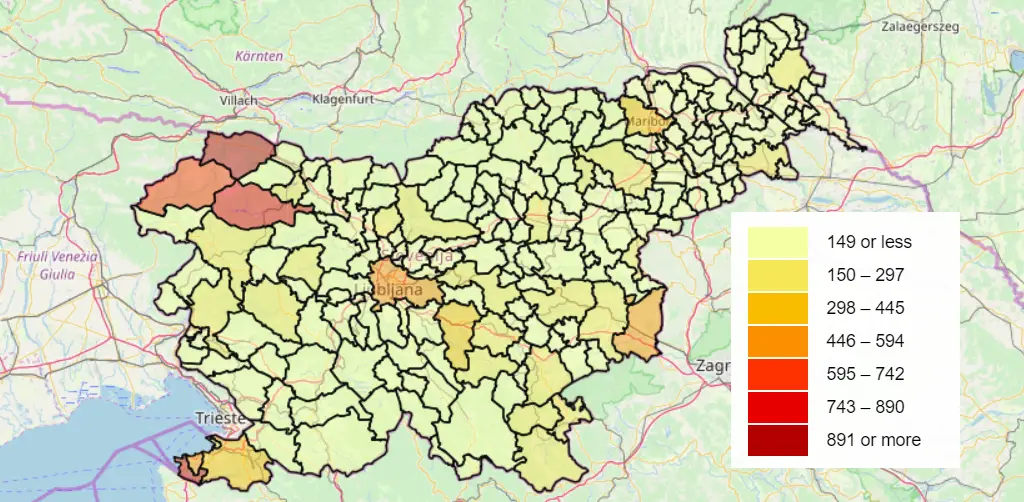
If you’re curious about some of the homes on the market, then check our real estate section, while all our stories on property are here.
STA, 19 December 2019 - There were 2,089,310 residents in Slovenia on 1 July 2019, of whom there were more men than women for the first time in 160 years, show the latest Statistics Office (SURS) data. There were 2,360 more men than women. This trend can only be seen in three other EU countries, Sweden, Malta and Luxembourg.
"This is mostly a result of immigration, since the majority of immigrants in Slovenia are men," Barica Razpotnik explained at Thursday's news conference in Ljubljana.
However, the immigrants excluded, the country's population increase was negative in the first six months, as the number of newborns was below the number of people who died.
Related: Survey - Young Slovenian Women Unhappy at Work, Would Move Abroad
Related: Where to Find the Most Women in Slovenia
Taking into account the immigrants, the increase in the country's population in January-June was positive.
As many as 28,455 moved to Slovenia last year and 13,527 moved out of it, so the difference of nearly 15,000 makes for the steepest rise in foreigners in 10 years.
As a result, the number of foreign citizens in Slovenia increased to 6.6% in 2018, Razpotnik said.
Half of the foreigners who immigrated here were from Bosnia and Herzegovina.
An average foreigner who moved to Slovenia last year was a 32-year old man with Bosnian citizenship who has completed vocational education and had a job in the construction industry.
The number of immigrants granted Slovenian citizenship in 2018 stood at 1,978, of whom two-thirds were from Bosnia. A third were children under 15.
SURS director general Bojan Nastov said that projections showed Slovenia's population would be rising until 2023 and then start to slowly drop to reach 1,796,000 in 2100.
Another major change in coming decades will a major increase in the number of older people.
Related: Slovenia’s Aging Population, in Graphic Form
At the moment 20% of Slovenia's residents are older than 65, but the share is projected to grow to almost 32% by 2055.
Interestingly, the number of centenaries, now at 200, is to grow to around 5,600 in 2100.
Around one million people in the third quarter of 2019 were persons in employment, who clocked in an average 34 hours of work a week.
Nastov said it was encouraging that unemployment rate in the first three quarters of the year was below 5%, as opposed to over 6% in the EU.
The average monthly net pay was EUR 1,114, up 3.7% in nominal and 2% in real terms.
Monthly pay has been rising in the private and public sectors, and could well result in the highest annual pay growth since 2008 by the end of the year.
Higher pay translated into more disposable household income; in the first half of the year it was by 7% higher than in the same period in 2017.
Retail prices rose by 2% from the start of the year until the end of November, with inflation mostly fuelled by higher prices of food and non-alcoholic beverages, but also services, with Nastov highlighting higher health insurance.
This year's inflation was somehow cushioned by lower prices of fuel and energy.
Housing prices in the second quarter of the year rose by nearly 6% and the value of all sold housing units in that period amounted to EUR 330 million.
Over the past year and a half, the number of used homes sold totalled a record 3,452, whereas only 42 new homes were sold in this period.
More on all this data can be found here
STA, 3 December 2019 - The results of Slovenian 15-year-olds in reading, scientific and mathematical literacy tests are above the OECD average, shows the recent PISA study. Compared to the previous such study, the students have come off as less accomplished in reading and science literacy though.
The results of the study, which was conducted last year among some 6,400 15-year-olds, mostly secondary school first year students, have confirmed that Slovenian students of this age group excel in mathematical literacy.
Their scientific literacy is above the OECD average as well; however, the latest performance in this category shows a slight downturn - the same goes for the students' reading literacy, which significantly improved in 2015 compared to the PISA studies conducted in 2009 and 2012, but has now declined a bit.
Compared to the 2006 study, the first time such a study was conducted in Slovenia, the students' reading literacy in 2018 was pretty much the same, their mathematical literacy improved and scientific literacy slightly deteriorated, according to the Educational Research Institute, which carried out the Slovenian part of the study.
Last year's decline in reading literacy is a result of a worse performance across the spectrum, with the share of worst performers increasing by three percentage points to 18%.
Commenting on these developments, Education Minister Jernej Pikalo said that his ministry might have to discuss the efficiency of related measures from 2009.
Regarding scientific literacy, the average downturn resulted from a worse performance of the best performers, with their share dropping by four percentage points to 7%.
Meanwhile, girls achieved better results than boys in reading as well as scientific literacy last year - the former's performance was significantly better on average than in other OECD countries.
Slovenian students are also less motivated than their OECD peers worldwide - compared to 2009, the students' enjoyment experienced during reading in 2018 remained below the OECD average, with the students often expressing disappointment over the engagement and support of their teachers of the Slovenian language.
The minister is concerned over this lack of motivation, saying digital media were a distraction that pulls students away from books, while also highlighting that the signal regarding the teachers of Slovenian needs to be acknowledged.
The study also showed that the students spent an hour more on the internet in 2018 than in 2012 - altogether, more than three hours per day, which Pikalo thinks is another cause for concern.
The minister pointed out that the results did not necessarily always depict the actual situation in schools; however, he did acknowledge that Slovenia's educational system should cater better to gifted students.
He also highlighted that students needed to be able to not only understand texts but also to contextualise and use new information in the future.
All our stories about education in Slovenia are here
STA, 17 November 2019 - Some 46% of 20-24-year-olds in Slovenia are students, which is the highest share among EU countries, according to the Statistics Office. Slovenia had almost 76,000 students in the 2018/19 academic year, mostly women. More than half of all students enrolled in the first cycle graduate successfully, the statistics show.
In terms of the share of students among people aged between 20 and 24, Slovenia is followed in the EU by Greece (44%) and Poland (40%), the Statistics Office said ahead of World Students' Day, 17 November.
Slovenia Attracting Growing Number of Foreign Students
There are more women studying in Slovenia than men, and the share of women is also higher in most fields of tertiary education - pedagogy, health, social security, humanities, art, social sciences, information sciences, business and administrative studies, law, agronomy, veterinary studies, natural sciences, mathematics and hospitality and tourism.
Male students predominate only in technical studies, construction and ICT.
Some 60% of women and 42% of men enrolled in the first cycle of tertiary studies in 2010/11 finished their studies.
According to the Statistics Office, young people whose parents have tertiary education are more likely to enrol in tertiary education. In 2017/18, 71% of 19-24-year-olds with at least one parent who finished at least tertiary education enrolled in tertiary education.
All our stories about studying in Slovenia are here, while more statistics are here, and the SURS report for International Students Day, 2019, is below
STA, 12 November 2019 - Slovenian tourism is in for another record year in terms of arrivals and nights by foreign tourists, even if growth rates are slowing down in Slovenia and globally. And while some goals from the 2017-2021 national tourism strategy have already been achieved, there is still a lot to be done in terms of revenue and company restructuring.
Arrivals and nights by foreign tourists grew this year until August, by 7.1% and 3.5%, respectively, and revenue from foreign tourists rose by 3% to EUR 1.9 billion until the end of August, Economy Minister Zdravko Počivalšek told the press in Ljubljana on Tuesday.
This means two goals were already achieved in 2018, arrivals and nights, he said at the Days of Slovenian Tourism, the main tourism industry event in the country.
However, "the main goal of the strategy is EUR 3.7-4 billion in revenue from foreign tourists, which means a lot of hard work until the end of this period," he added.
Compared to the baseline year 2016, revenue from foreign tourists rose by 24% to EUR 2.7 billion in 2018, and only by another 3% since last year.
?Na Dnevih slovenskega turizma o projektih in izzivih, ki bodo spreminjali prihodnost slovenskega turizma #DST2019
— Slovenia Tourism (@tourism_slo) November 12, 2019
?Podrobnejši program so predstavili gostje na današnji novinarski konferenci v prostorih Grand Hotela Union.
?Več informacij➡️https://t.co/dX4cxtKRkk pic.twitter.com/UFBsog9bfW
Počivalšek also presented some other priorities: efforts to restructure state-owned tourism companies; making hospitality legislation more flexible; and public calls.
He said everything had been done to prepare the ground for the transfer of ownership and management of state-owned tourism companies to a state-owned fund.
Nevertheless, the minister said it was hard to say when this would actually happen, noting a plurality of different interests.
As for legislation, he said the hospitality sector needed simpler and fresher legislation that would enable it to develop gastronomy.
The ministry is also planning new calls for applications to distribute EUR 5.5 million to leading destinations in the coming two years.
Three million euro will be available for new products, EUR 21 million to make tourist accommodation and restaurants energy efficient and another EUR 5 million for the same purpose for mountain cottages.
Počivalšek also said that in 2017-2018, the state spent EUR 17.3 million on 121 projects that should bring 185 new or upgraded tourist products plus 190 new jobs.
Speaking at the same news conference, Slovenian Tourism Association head Pavle Hevka stressed tourism was the most important sector of economy for Slovenia.
He believes it facilitates quality development to the capital city, as well other smaller and bigger towns, villages and even more remote parts of the country.
Slovenian Tourist Board (STO) director Maja Pak said the STO would continue to focus on digital advertising, working with journalists and influencers.
It will moreover present Slovenia at global tourist and other events, including Expo in Dubai and the Olympic Games in Tokyo, while also planning to use Slovenia's EU presidency in 2021 as a promotional opportunity. Gastronomy will also be an area in the focus in the next two years.
This year's Days of Slovenian Tourism are organised by all leading partners in the industry under the wing of the STO.
The other day we presented STAGE II, a fascinating interactive map produced by SURS (Statistični urad Republike Slovenije - the Statistical Office of the Republic of Slovenia). However, while pretty to look at some data is best expressed in other ways, and if you’d prefer to read a text-based summary then don’t worry, SURS has got that covered, offering reports on each of Slovenia’s 212 municipalities.
Your journey begins at the level of statistical regions. There are 12 of these in total, in varied size with regard to geographic area and the number of municipalities they contain. Podravska, for example, has 41 municipalities, while Zasavska just four.
Go down to the next level – in the example at the top of this page hit “Region has 25 municipalities” – and you’ll get a profile of the region, along with a population pyramid to show the demographics, which are not great anywhere in Slovenia, but still better than elsewhere in the former Yugoslavia.
See the list of names on the left and you can then visit each municipality in turn. For illustrative purposes I chose Logatec, because I’m moving there at the end of the month. Here I can learn, for example:
- The mean age of people in Logatec [in 2016] was 39.9 years, which was lower than the national average (42.9).
- The population density was 80 people per square kilometre, which was lower than the national average 102 people per square kilometre.
- Among people aged 15–64 (i.e. working age population) about 65% were persons in employment (i.e. persons in paid employment or self-employed persons), which is more than national average (60%).
- In 2015, there were 343 dwellings per 1,000 population. About 69% of dwellings had at least three rooms. Average size of dwellings in the municipality was 90 m2.
Find out more about where you live here, while all our stories on statistics in Slovenia are here
SURS (Statistični urad Republike Slovenije - the Statistical Office of the Republic of Slovenia) runs one of the best government websites in the country, producing a regular stream of interesting and informative reports drawn from the numbers it receives, presented in clear, easy to understand formats, and with the raw data just a few clicks away if you want to dig deeper.
Screenshot of the mean age data around Ljubljana. Source: SURS
Mean age in detail, with a focus on Logatec. Source: SURS
One tool that’s a lot of fun to play around with, and a fresh way to explore the country, is STAGE II – “an interactive cartographic application for displaying statistical data about Slovenia. It provides interactive web map viewer as well as provides powerful analytical tools for spatial querying.”
Poverty in broad terms Source: SURS
Where the Novaks are. Source: SURS
With this you can check the data is 15 broad headings: population, the labour market, earnings, poverty, education, health, crime, enterprises, industry, dwellings, construction, environment, agriculture, R&D, and national accounts. Within each of these you can dig deeper in a series of nested categories, in some cases going into incredible detail. For example, the most densely populated square kilometre in Slovenia is located in the Štepanjsko naselje in Ljubljana with 11,217 residents.
Population density by 1km2, Source: SURS
If you want to find out where the most statins are prescribed or which place sees the most binge drinking, then you can, along with where the most old homes are, where the highest mean age is, where there are more men than women, and so on. Available in Slovene and English, you can explore Slovenia in dozens of ways here.


